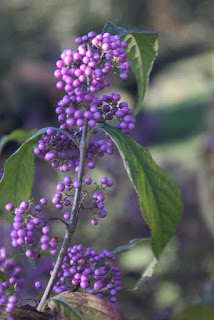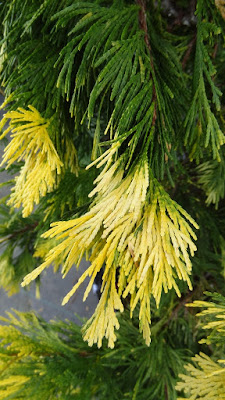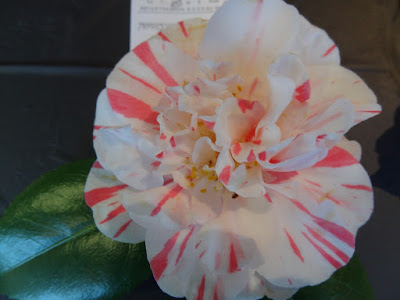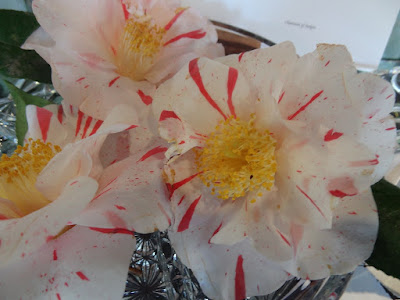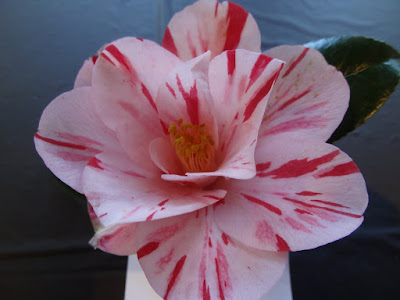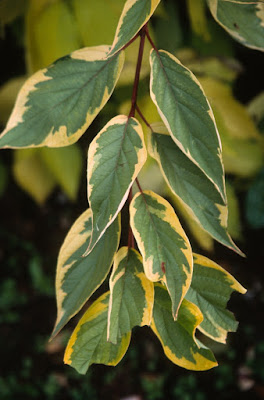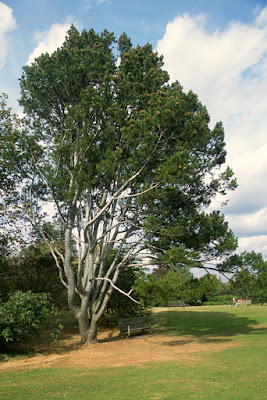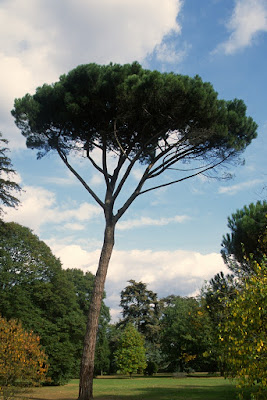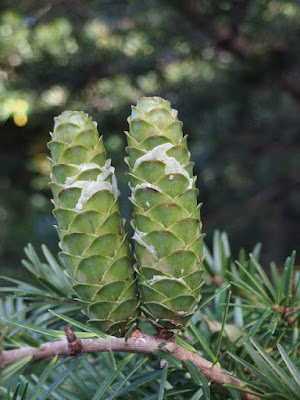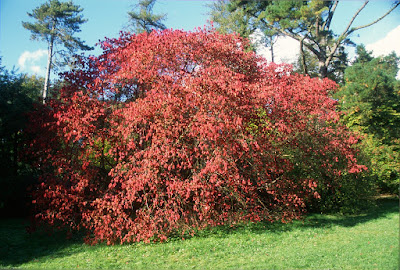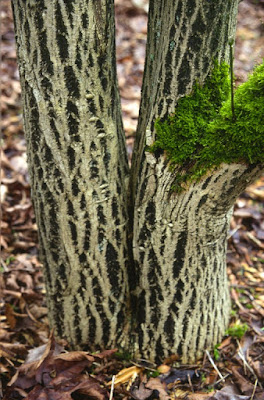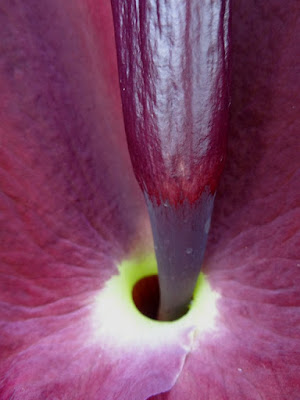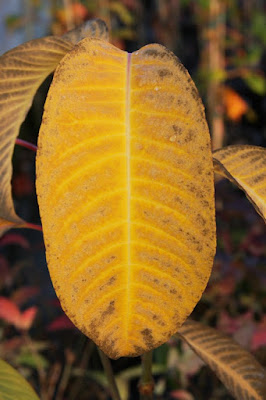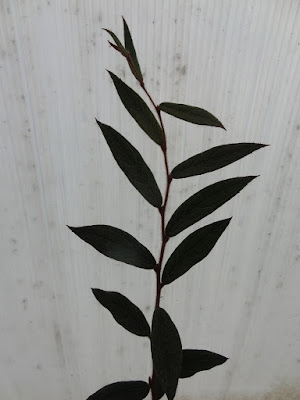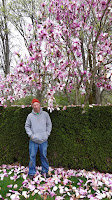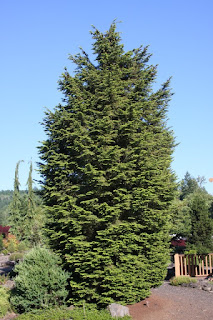One of the following happened to me last week:
1) Eric and Seth both quit.
2) I bought a horse.
3) I broke my leg.
4) My daughter Saya eloped.
5) I was in a traffic accident.
6) I retired.
Not number six – I didn't retire – but I am tired. Number five happened, as a young man sped through a red light and T-boned me. Fortunately no one was hurt, but the incident has left me rather disoriented. If the accident would have been fatal I could have finally found a nursery exit-strategy.
Anyway the blog never got past page one, but hopefully I can finish it next week. The following is from about a year ago, a re-blog if you will.
--------------------------------------------------------------------------------------------------------------------------------------------------------------------------------
![]() |
| The Old Office |
It's been nearly fifteen years since we moved from the old office into our current command center. My goal was to slowly (but surely) toss what wasn't really needed and to incorporate the remainder into our office system of today, especially since I now employ personnel who are far more diligent and capable. But every time I would venture into the old place I dredged up history and memories of the good, the bad and the ugly. So usually I would walk out with a sigh and leave the task for another day. Thence fifteen years have passed.
![]() |
| Whet stone |
I was prompted to re-enter, however, as we have begun our winter grafting and the crew announced that they needed more whet stones. Not whet stones for their dull wits, rather for their Tina grafting knives. The term is derived from Middle English whetston and that from Old English hwetstan, and in German it is wettstein. In England a few places where suitable stones for sharpening could be found are Whetstone in Leicestershire and Greater London, or from Wheston in Derbyshire. Never mind that, as in America we have excellent sharpening stones from Arkansas...and our supply should be located somewhere in the old office.
![]() |
| Order index cards |
So in I went, determined to prove to my over-spending staff that we had plenty of stones, and that how we organized (or disorganized) our supplies was the issue. Drawers, cupboards and shelves were checked, but to no avail. I did find a box full of late 1980's index cards, where each card recorded the number of grafts or rooted cuttings that were on order for the following spring. For example, for Tsuga canadensis 'Cole's Prostrate'– a cultivar we no longer propagate – 900 rooted cuttings were on order from twelve different companies. When the cuttings were shipped the entry would then be crossed off. For Juniperus squamata 'Blue Star', over 12,000 were on order from twenty eight companies. On a sour note was record of a Minnesota company that ordered for many years, then declared bankruptcy and screwed me out of $20,000. More fondly, I discovered evidence that we used to sell to the San Diego Zoo, to horticulturalist Jim Gibbons (no kidding!) in particular. His orders were small, but he appeared determined to test “true firs,” such as Abies pindrow for the San Diego environment.
![]() |
| The old catalog drawer |
Well that was a little fun, but I threw the box out. Streamline, simplify and pare the business down to the essentials only. But one drawer contained dozens of old European nursery catalogs and maps. These are useless now but I began to flip through them nevertheless. Eventually I made a coffee and sat to study them in earnest.
![]()
One surprise was the Stangby Plantskola prislista(price list) from...where? I could see from a map that this nursery was located near the city of Lund, and a quick google revealed that it was located in southern Sweden. The city of about 100,000 is among the oldest cities in Sweden and was founded in the late 10th century. The Lund cathedral is nearly as old and was built in traditional Romanesque style; it features an astronomical clock, five organs and an ancient crypt. The botanical garden (Botanisk Tradgarden) is popular with foreigners as well as with the denizens of Lund. Lovisa B. “loves having a picnic with friends in the summer,” Martin from Ireland claims it is “Beasutiful [sic] for a stroll” and Sophie A. from Athens calls the garden “amazing.” Alan M. from Shaftesbury, United Kingdom, importantly notes that the garden is free. All of that sounds wonderful and I would love to see the garden, perhaps with Lovisa and her friends, as well as the Stangby Plantskola. But I have never been to Sweden, and I'm not sure just how I came upon their prislista. Perhaps a Swedish nurseryman visited years ago and dropped it off. He would be old like me now, except that he would be retired and socialistically comfortable, whereas I must still grind out a living.
![]()
![]() |
| Acer palmatum 'Inaba shidare' |
I have thrice been to Boskoop, The Netherlands, and I began to page through the town brochure which celebrates their Vijf Eeuwen Boomkwekerij, or “five centuries of nurseries.” I read that more than half of Boskoop's 14,000 people work at the area's 900 nurseries, which are usually long and narrow – the nurseries that is – and are sited along 500 kilometers of canals and ditches. I took a canal tour about fifteen years ago, and I remember the bank-side nurserymen – old and young, male and female – bent to the ground, toiling on their tiny plots with peaty fingers, scratching out a living on their rectangular islands. The most important tool is said to be “the skilled hands of the nurseryman,” and “due to a vulnerable soil structure only limited use of machinery can be made.” Most of the product is exported to more than 75 different countries, and I too once received shipments from Boskoop. Most of the time the product was of good quality and true-to-name, but once the Boskoopians substituted Acer palmatum 'Select Red' for 'Inaba shidare', as if the two cultivars were the same. Absolutely they are not, and I knowthat they knew, but then they supposed that American nurserymen were not sufficiently sophisticated to see the difference, and that it wouldn't really matter after all.
![]()
![]() |
| Acer shirasawanum 'Aureum' at Firma Esveld |
Acer shirasawanum 'Aureum'
Acer shirasawanum 'Mr. Sun'
A must-stop in Boskoop is the Firma C. Esveld, and in my drawer I rediscovered their Catalogus of 1991-1993. The van Gelderen family runs the show, and they explain that they “do the job” with fifteen people (parents, two sons, a daughter-in-law and ten regular staff). My last visit in 2012 revealed a nursery with no such staff anymore, but the Acer collection, which they call the Aceretum, has matured nicely. The anchor is the famous Acer shirasawanum 'Aureum' which is probably the oldest and largest in the world. Their 1991-1993 catalogus lists just under 200 cultivars of Acer palmatum, but their online listing today reveals they now grow many more, including most of my introductions, even those I am least proud of ('Red Wonder', 'Green Fingers', 'Uncle Red' and others). The text of Esveld's old catalog, plus the modern online version, is rendered in English as well as Dutch. My description of Acer shirasawanum 'Mr. Sun' begins, “A broad, upright deciduous tree with sharply pointed green leaves that resemble a child's drawing of the sun.” Humorously, Esveld offers, “Leaves do think on childrens drawing of sunny with rad.”...which reminds me of my wife when she asked Dutchman Nelis Kools how to say, 'Nice to meet you,” just before she was about to meet his brother for the first time. Haruko chirped “luk tu en tu muten.” The brother blurted out, in English, “What!, my mother died?”
![]() |
| Abies koreana 'Silberlocke' |
![]()
![]() |
| Mrs. Horstmann and son |
In the year 2,000 I was fortunate to visit the Horstmann Nursery, but I was too late to meet the founder Gunter Horstmann, for he died a few years previous. I was travelling with a bus-load of “cone heads,” or conifer aficionados from the American Conifer Society. Horstmann was primarily known for his discovery and introduction (1986) of Abies koreana 'Silberlocke', a dazzling selection where the needles curve around the stems and reveal the glittery-silver undersides. We were all handed a
Zwergkoniferen-Sammlung Horstmann Schneverdingen, which translates as “Dwarf Conifer Collection” of Horstmann Baumschulen (nursery) from the town of Schneverdingen, Germany. We received the
Gesamtliste– the “total list” – which at Buchholz Nursery I call my “Master Plant List.” I was surprised to find a few of my introductions, none of which came directly from me: such as Chamaecyparis nootkatensis 'Green Arrow' and 'Laura Aurora', Metasequoia glyptostroboides 'Jack Frost', Pinus bungeana 'Temple Gem' and Pinus mugo 'Woods Columnaris' which I originally named 'Wood's Pillar', as I believe I was the first to propagate from a narrow seedling growing next to the home of the late Edsal Wood. I also noticed a Sequoiadendron giganteum 'Moonie's Mini', which was originally discovered as a witch's broom mutation along McLoughlin Blvd. in SE Portland, Oregon, a selection named for an itinerant grafter (Will Moonie) who first climbed the tree to procure scionwood for Buchholz Nursery.
![]() |
| Pinus parviflora 'Tanima no yuki' |
The nomenclature of Horstmann's gesamtliste was not the plantsman's forte, and many errors abound; or perhaps he was spot on and the rest of the plant world is incorrect. But I take issue with Abies balsamea 'Welcott Pond' which should be 'Wolcott Pond', Cedrus deodara 'Raiswood Contorta' which should be 'Rayswood's Contorted', Cedrus deodara 'Feeling Blue' which should be 'Feelin' Blue', Cedrus deodara 'Golden Nugged' which should be 'Gold Nugget', Chamaecyparis obtusa 'Tatsunami' which should be 'Tsatsumi', Chamaecyparis obtusa 'Draght Hexe' which is actually a selection of the C. lawsoniana species and on and on. But anyway, Horstmann was well-known throughout Europe for his unusual nursery, and his sloppy list does little to detract from his illustrious career with his many wonderful plant introductions. And besides, the mistakes are easily solved, such as the incorrect listing of the cultivar Pinus parviflora 'TamMano Uki' which is obviously what we correctly know as 'Tanima no yuki'.
![]()
![]() |
| Mrs. Jeddeloh toasting her visitors |
I also discovered a zu Jeddeloh Pflanzen catalog from 1995-1996. Oddly I had not been to Jeddeloh nursery until October, in the year 2000. Apparently what they handed out to us was old literature with the main goal of cleaning out their office storage room, especially since none of us would be buying anything from them. In any case we were treated to a brimming tablespoon of vile schnapps as a traditional northern German welcome. I winced as I swallowed my dose, but soon thereafter I was glowing with warmth.
Acer japonicum 'Aconitifolium'
Maple listings in the old Jeddeloh catalog were sparse, and all was in German. For Acer japonicum 'Aconitifolium' they describe Japan-Ahorn Frischgrüne Blatter, in Herbst feurig rot, and even with my limited knowledge of German – from which English is derived – I could figure out it meant “Japanese Maple Tree with fresh green leaves, in fall fiery red,” or at least something close to that. For Acer palmatum 'Atropurpureum', it was described as Fächerahorn Rotblättrig, which strangely means “fanmaple tree with red leaves.” Acer palmatum 'Viridis' is Zwergahorn Grüne Blätter, tiefgeschlitzt which means “dwarf maple tree with green leaves,” but the tiefgeschlitztpart is beyond me, and also beyond my German-to-English dictionary.
![]() |
| Quercus robur 'Purpurea' |
The Jeddeloh catalog lists Quercus as Eiche, German for “oak.” Interestingly, eichhörnchen is German for “squirrel.” Quercus rubra is Amerikanische Rot-Eiche, or “American Red Oak.” Quercus robur is listed as Deutsche Eiche, or “German Oak.” In France, by the way, the species is listed as “French Oak,” in England as “English Oak,” and in Russia as “Russian Oak.” I got a kick out of some German common names. Araucaria is Schmucktannewhich means “smart or trim fir,” Symphoricarpos is Schneebeere– and what fun to say! – which means “snowberry,” Cryptomeria is Sicheltannewhich means “sickle fir” and x Cupressocyparis is Bastardzypresse, which needs no further explanation.
![]() |
| Johann (left) and son Jan-Dieter Jeddeloh (right) |
![]() |
| Grandson Jan-Dieter Jeddeloh in the Buchholz Display Garden |
Coincidentally, the day after I discovered this Jeddeloh – pronounced yed de low– catalog I was visited by the third generation of these plantsmen. I guess it speaks to my longevity that grandfather Johann, his son Jan-Dieter, and grandson (also) Jan-Dieter have been to Buchholz Nursery. I envy the Jeddelohs and their history, for the family and their village share the name of Jeddeloh, and the forefathers have been cultivating the land for fifteen generations. I'm sure that their product line has changed greatly since the 1995-1996 catalog, as most nurseries have. Also Jeddeloh Nursery does little of their own propagating now, as it is possible to buy quality liners from other nurseries, and today Jeddeloh could be considered as growers-onersand distributors. Their loading docks are active day and night with plants shipped throughout all of Europe and Russia. When shipping to Russia, the cost of freight must also include a substantial portion to cover the required bribes to get the product to its destination.
![]()
The German Wittboldt-Müller nursery catalog from the year 2,000 reminded me of my first visit, also with the group from the American Conifer Society. We had a wonderful botanical tour through Holland and Germany, with Dutchman Van Hoey Smith as our master of ceremonies and his delightful daughter Joan as the logistics coordinator. Everyone on the bus got along well, and every day we had the opportunity to sit with somebody new. After spending a long day next to an interesting woman, she concluded that I was very different from whom she thought I would be (due to my "reputation"). I responded by saying, "So, I'm not really an asshole after all." She laughed and said "Yes, that's right."
![]() |
| Sciadopitys rows at Wittbold-Müller |
![]() |
| Sciadopitys verticillata 'Fireworks' |
![]() |
| Sciadopitys verticillata 'Green Star' |
![]() |
| Sciadopitys verticillata 'Gold Rush' |
The Wittboldt-Müller catalog features all types of plants in color, most never grown at the nursery. Apparently German nurseries do this because they can provide a one-stop shopping experience for their customers, and the perennials, shade trees and shrubs can easily be procured from their associates at other nurseries. The one product that they did grow, and specialized in, was Sciadopitys, the "Japanese Umbrella Pine." All were grown from seed, and every year they would germinate thousands more. I think they said it took seven years before a tree was sold. Naturally with thousands of seedlings some variation would occur, and this led to cultivar selections such as 'Fireworks', 'Green Star' and 'Gold Rush'. Sadly the nursery had fallen on hard times and my last visit in October, 2007, revealed a nursery in disrepair with only two employees and overgrown, crowded stock trees. Maybe the German market had their fill of Sciadopitys, but it was a shame to see them go to waste.
![]()
Upon entering the Von Gimborn Arboretum near Doorn, the Netherlands, I was issued a guidebook. In the preface the Arboretum Director (V.P.A. Lukkien) states "I wish you, when you are walking through the Arboretum with this guide in hand (for it is not ment [sic] for the bookshelf at home), many pleasant and studious hours." In the section Guidelines for the visitor, we are admonished to keep our dog on a leash, to not pick the flowers, and to not mess around with any of the labels. The final guideline: "To give a zest to your stay, you are allowed to bring food and drink but do not trouble other visitors or us with any litter whatsoever."Fair enough.
![]()
Pinus parviflora 'Gimborn's Pyramid'
I was anxious to see the Gimborn collection for I grow a few trees that were selected there, such as Pinus parviflora 'Gimborn's Pyramid', 'Gimborn's Ideal' and 'Tempelhof', and Tsuga mertensiana 'Blue Star'. Max Von Gimborn began the park-arboretum in 1924, and his goal was to gather as big a collection as possible of conifers, both species and cultivars. When he died in 1964 his wife arranged for the arboretum to become the property of Utrecht University Botanic Gardens.
![]() |
| Tsuga x jeffreyi |
I saw a good number of Pinus parviflora trees, but the labeling was sparse and I couldn't identify any as being 'Gimborn's Pyramid' or 'Gimborn's Ideal'. I was hoping they would be growing side-by-side, so I could finally tell the difference, if any, because as younger plants they look alike. The 'Blue Star'"Mountain Hemlock"– the original tree – looked nice, but with pretty much the same foliage color as 'Bump's Blue' which I have grown for thirty years. Of more interest to me was a specimen of Tsuga x jeffreyi, the naturally-occurring hybrid between T. mertensiana and T. heterophylla, a tree that I have never grown or even seen before. Supposedly at least one location for it is at White Pass on the southern flank of Mt. Rainier in Washington state.
I doubt that I'll ever go back to the Gimborn, mainly because there's so many other quality places in Holland. Maybe it is better today, but I really have a problem with a tree collection that lacks labels. One stated purpose is the "conservation of old cultivars which are no longer commercially available." I disagree, for there is a reason they are no longer commercially available. I'll actually say it: with the exception of a few interesting specimens, I found the Von Gimborn Arboretum kind of boring.
So now my coffee is cold; I forgot to drink it being so absorbed with the old catalogs, and I'll toss them back into the drawer, for they weren't doing any harm there anyway. No whetstones to be found, but I had a good time.






